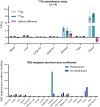212Pb-Pretargeted Theranostics for Pancreatic Cancer
- PMID: 37945380
- PMCID: PMC10755526
- DOI: 10.2967/jnumed.123.266388
212Pb-Pretargeted Theranostics for Pancreatic Cancer
Abstract
Although pancreatic ductal adenocarcinoma (PDAC) is associated with limited treatment options and poor patient outcomes, targeted α-particle therapy (TAT) represents a promising development in the field. TAT shows potential in treating metastatic cancers, including those that have become resistant to conventional treatments. Among the most auspicious radionuclides stands the in vivo α-generator 212Pb. Combined with the imaging-compatible radionuclide 203Pb, this theranostic match is a promising modality rapidly translating into the clinic. Methods: Using the pretargeting approach between a radiolabeled 1,2,4,5-tetrazine (Tz) tracer and a trans-cyclooctene (TCO) modified antibody, imaging and therapy with radiolead were performed on a PDAC tumor xenograft mouse model. For therapy, 3 cohorts received a single administration of 1.1, 2.2, or 3.7 MBq of the pretargeting agent, [212Pb]Pb-DO3A-PEG7-Tz, whereby administered activity levels were guided by dosimetric analysis. Results: The treated mice were holistically evaluated; minimal-to-mild renal tubular necrosis was observed. At the same time, median survival doubled for the highest-dose cohort (10.7 wk) compared with the control cohort (5.1 wk). Conclusion: This foundational study demonstrated the feasibility and safety of pretargeted TAT with 212Pb in PDAC while considering dose limitations and potential adverse effects.
Keywords: lead-203; lead-212; pretargeting; progeny release; targeted α-therapy.
© 2024 by the Society of Nuclear Medicine and Molecular Imaging.
Figures







References
-
- Raja C, Graham P, Abbas Rizvi SM, et al. . Interim analysis of toxicity and response in phase 1 trial of systemic targeted alpha therapy for metastatic melanoma. Cancer Biol Ther. 2007;6:846–852. - PubMed
-
- Jurcic JG, Rosenblat TL. Targeted alpha-particle immunotherapy for acute myeloid leukemia. Am Soc Clin Oncol Educ Book. 2014:e126–e131. - PubMed
Publication types
MeSH terms
Substances
Grants and funding
LinkOut - more resources
Full Text Sources
Medical
